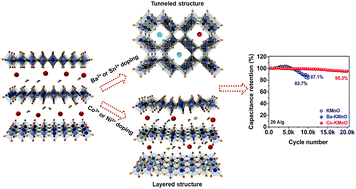Stabilization of layered manganese oxide by substitutional cation doping†
Abstract
Manganese oxides (δ-MnO2) with a layered structure are considered as potential electrode materials due to the presence of an extra ion transport channel between interlayers. However, their dissolution and structure collapse during the electrochemical charge and discharge process usually lead to rapid capacity fading. In this study, we designed a metal-ion (Ba2+, Sn2+, Co3+ and Ni2+)-doped two dimensional (2D) δ-MnO2 to improve the stability of the layered structure. Both the experimental and the theoretical calculations indicated that Co3+ and Ni2+-doped 2D δ-MnO2 (2D Co–KMnO and Ni–KMnO, respectively), obtained via a substitutional doping route (by replacing the Mn atom), could efficiently stabilize the layered structure. Moreover, the 2D Co–KMnO electrode material exhibited a high specific capacitance (342.7 F g−1) and excellent cycling performance, with 95.3% capacitance retention after 20 000 cycles at the current density of 5 A g−1. This study revealed the mechanism of the effect of the doping behavior of metal ions on the crystal stability of metal oxides, possibly paving a new path for the rational design of other robust functional nanomaterials.



 Please wait while we load your content...
Please wait while we load your content...